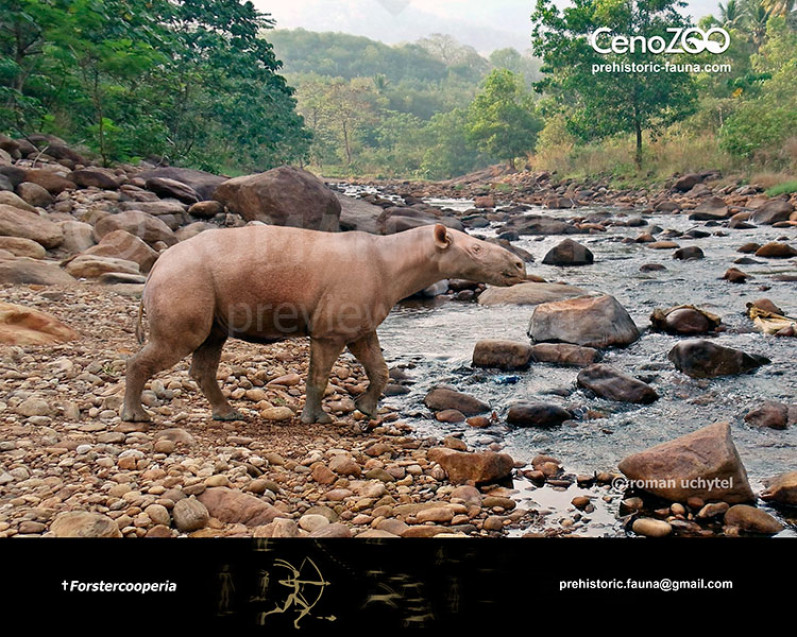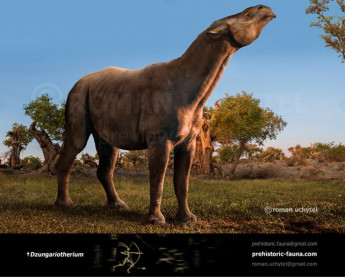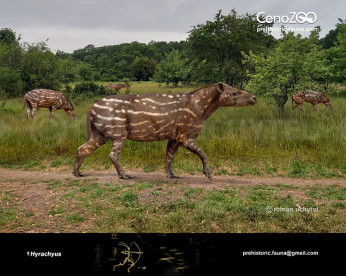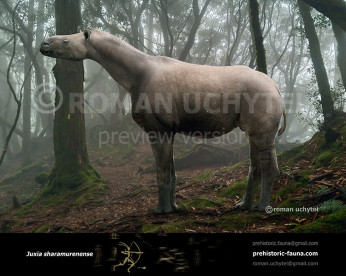Forstercooperia
2841828418
Forstercooperia (†Forstercooperia (Wood, 1939))
Synonyms: Cooperia totadentata (Wood, 1938)
Order: Perissodactyla
Suborder: Ceratomorpha
Superfamily: Rhinocerotoidea
Family: †Paraceratheriidae
Time period: Middle Eocene, 47–42 Ma (Asia)
Size: 1,5 m in length, 80 cm in height, ~80 kg of weight
Typical representative: †Forstercooperia totadentata Wood, 1938
The subfamily Forstercooperiinae, to which Forstercooperia belongs, is considered part of Paraceratheriidae, a group containing the largest land mammals ever to walk the earth. Forstercooperia is known from a vast amount of cranial material, although only some scant postcranial remains. The average size of the animal is about equal with a large dog. Like primitive rhinocerotoids, Forstercooperia possesses blunt ends on the tips of its nasals, above the nasal incision. Unlike all modern rhinoceroses, the nasals of Forstercooperia, as well as many related genera, lack rugosities, which suggests that they lacked any form of horn.
The superfamily Rhinocerotoidea can be traced back to the early Eocene—about 50 million years ago—with early precursors such as Hyrachyus. Rhinocerotoidea contains three families; the Amynodontidae, the Rhinocerotidae ("true rhinoceroses"), and the Hyracodontidae. The diversity within the rhinoceros group was much larger in prehistoric times; sizes ranged from dog-sized to the size of Paraceratherium. There were long-legged, cursorial forms and squat, semi aquatic forms. Remains of Forstercooperia have been found all across Asia.
Оплата
У Вас є кілька зручних способів купівлі зображення: кредитна чи дебетова картка Visa, Mastercard, Maestro; PayPal або банківський переказ
Forstercooperia (†Forstercooperia (Wood, 1939))
Synonyms: Cooperia totadentata (Wood, 1938)
Order: Perissodactyla
Suborder: Ceratomorpha
Superfamily: Rhinocerotoidea
Family: †Paraceratheriidae
Time period: Middle Eocene, 47–42 Ma (Asia)
Size: 1,5 m in length, 80 cm in height, ~80 kg of weight
Typical representative: †Forstercooperia totadentata Wood, 1938
The subfamily Forstercooperiinae, to which Forstercooperia belongs, is considered part of Paraceratheriidae, a group containing the largest land mammals ever to walk the earth. Forstercooperia is known from a vast amount of cranial material, although only some scant postcranial remains. The average size of the animal is about equal with a large dog. Like primitive rhinocerotoids, Forstercooperia possesses blunt ends on the tips of its nasals, above the nasal incision. Unlike all modern rhinoceroses, the nasals of Forstercooperia, as well as many related genera, lack rugosities, which suggests that they lacked any form of horn.
The superfamily Rhinocerotoidea can be traced back to the early Eocene—about 50 million years ago—with early precursors such as Hyrachyus. Rhinocerotoidea contains three families; the Amynodontidae, the Rhinocerotidae ("true rhinoceroses"), and the Hyracodontidae. The diversity within the rhinoceros group was much larger in prehistoric times; sizes ranged from dog-sized to the size of Paraceratherium. There were long-legged, cursorial forms and squat, semi aquatic forms. Remains of Forstercooperia have been found all across Asia.


-797x638.jpg)

-70x56.jpg)



-346x277.jpg)